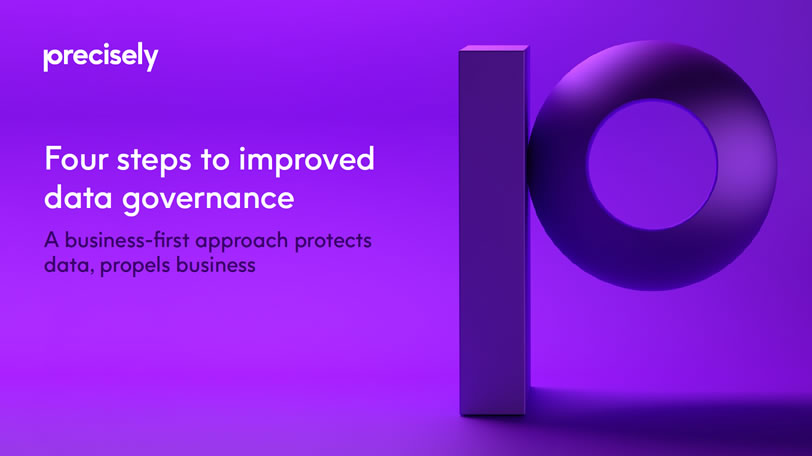eBook
Four Steps to Improved Data Governance - A business-first approach
Getting started with data governance
Corporate leadership wants to minimize risk, increase insight, and improve operations. They need a strong a data governance program.
Now what?
Building data governance from the bottom up is difficult. It requires input from stakeholders throughout the organization. But too often, data governance arises as a siloed, overly-complex framework, one that leaves employees feeling disconnected. They don’t understand how data governance supports business goals or impacts their everyday work. At the same time, they’re asked to attend governance meetings, to align processes, to define terms, to provide insight into data usage. Governance strategy becomes bogged down in minutiae. It loses focus.
With no tangible improvement in insight, operations, or risk posture — and no clear return on investment — corporate leadership loses enthusiasm. They may even consider defunding governance efforts, losing out on their benefits altogether.
There’s a better way. Start your governance program with a business-first approach that engages employees, quickly delivers some high-value, low-effort wins, and establishes a foundation for growth.
This approach:
1. Links data governance to business goals
2. Prioritizes the governance of critical data
3. Builds engagement across organizational levels
4. Creates enthusiasm among employees by communicating value and celebrating successes
Here’s how you can get started.

Link governance to business goals
A business-first governance strategy identifies corporate goals and initiatives and builds governance capabilities around them.
How does this alignment play out? Suppose that, in an effort to boost customer loyalty and attract new consumers, a company wants to personalize its goods and services. Organizational stakeholders include marketing, sales and finance teams. Business goals include increasing the company’s net promoter score by 5%, increasing purchases from repeat customers by 17%, and reducing churn by 11%.
Governance objectives in support of these business goals include establishing a single customer view. Capabilities that governance
teams can deploy to meet that objective include centralizing collection of customer data, establishing a data catalog, visualizing data lineage of upstream/downstream relationships, and automating data integrity rules to give appropriate users easy access to data.

Precisely helps Johnson & Johnson streamline supply chain management
With more than US$93.8 billion in annual sales and 130,000 employees, Johnson & Johnson is one of the world’s largest producers of pharmaceuticals, medical devices, and consumer goods. It wanted to implement a single enterprise resource planning/supply chain solution for its 250 operating companies. However, implementation of such a solution was hampered by disparities in how data was defined and how systems of record were aligned among more than 50 ERP systems. The lack of data standards and organizational ownership further obscured the path to system consolidation. A data governance solution was needed.
Johnson & Johnson worked with Precisely to develop an enterprise information management strategy to prepare for coalescing data for a single supply chain management solution. The process started with Precisely facilitating the appointment of an enterprise level data governance and analytics board. Precisely software enabled the board and other stakeholders to capture data governance design in Precisely Data360. Data management optimization and additional data governance efforts bolstered insight, enabling Johnson & Johnson to accelerate the deployment of an organization-wide enterprise resource planning/supply chain management solution.
As part of this solution, the Precisely team provided additional expertise in the creation of change control procedures, data standardization, scorecard metrics to measure each data domain, region, and process area, team risk review, and executive coaching and guidance.
Link governance to business goals:
Four considerations for prioritizing business-focused governance projects
From improving overall customer retention to meeting personal sales goals, every employee has a business priority. Your first governance iteration can’t possibly support them all. How to prioritize?
Start with low-effort, high-value initiatives that illustrate the value of data governance and produce quick wins. You may want to use a prioritization framework covering reach, impact, confidence and effort.
- Reach: Will this new data governance initiative help the entire North American arm of your multinational corporation reach an overarching business goal, such as “increasing profits” or “improving efficiency?” Or will these capabilities make life a little easier for the ten people in your Philadelphia office?
- Impact: What impact will the data governance initiative have on your business or its customers? Will it help millions of bank consumers to access new credit options? Or will it enable a small subset of consumers to obtain slightly reduced interest rates on their car loans?
- Confidence: How sure are you that your governance initiative will help the company meet a specific business goal? Do you have
metrics to back up your beliefs? - Effort: How much governance effort will it take to reach a business goal? How much time will it require? Does your team have the skills needed in-house?


Link governance to business goals:
Separate needs from wants when selecting capabilities
Initial data governance initiatives should separate what capabilities the organization truly needs to reach a specific goal from those capabilities it would simply like to have.
Group data governance components into “must haves” and “nice to haves.” Anything that supports high-priority goals or is attached to multiple identified business objectives is a “must have.” Anything else is a “nice to have” that can be deployed later.
In the personalization scenario above, “must haves” may include centralized collection of customer data, a data lineage flow, and automated approval of workflows. “Nice to haves” may include machine learning capabilities that help the business determine whether certain data fields in each customer profile are more trustworthy than others.
Prioritize data to be governed
You may feel overwhelmed by the sheer volume of data running through your organization. This includes both structured data such as sales transactions and CRM entries, and unstructured data including sensor data or information captured from social media feeds.
The good news is, you don’t have to govern all of it right away.
Precisely estimates that only about five percent of data is critical for delivering insight, minimizing risk, and improving operations (see Figure 1). Reduce governance time-to-value by concentrating on just that critical data at first. This focus simplifies data governance significantly by limiting the amount of data to be governed in alignment with any single business goal from perhaps thousands of elements to just a few dozen.
Master data is most often a critical sub-set of the data to be governed. Customer names and addresses. Account information. Market segmentation information. Billing and credit info. A lean data catalog may include nothing more.

Figure 1: Your company has a lot of data. But it’s only critical that you govern about five percent of it.
Build engagement across three corporate tiers
Stakeholder engagement is vital to data governance. For a successful governance program, you need to solicit engagement across your organization’s tactical, operational, and strategic levels.
To do this, build meaningful KPIs measuring:
- Current and future-state efficiencies at the tactical level. Data analysts, data scientists, data stewards, data engineers and others want KPIs that measure improvement in data access and movement, data completeness, and improved curating.
- Improved business processes, performance, and scalability at the operational level. Business process leads, data governance leads, data management leads, information architects and other professionals want KPIs measuring improvement in data quality, reduction in data errors, and reduced cycle times.
- ROI and transformation efforts at the strategic level. CEOs, CIOs, CDOs, data and analytics leads, and business transformation leads value KPIs measuring improvement in process enablement, customer sentiment, and project acceleration, among other benefits.
To be effective, governance initiatives need to include all three levels. And KPIs must link across organizational levels to tell the complete story of how governance supports business goals. The complete data governance story may run something like:

Communicate value to stakeholders throughout the business
Successful governance programs don’t just measure success across key organizational tiers. They create enthusiasm among employees by communicating value and celebrating successes.
Typical governance initiatives ask too much from stakeholders, without providing tangible benefits in return. Employees are required to attend meetings, define key terms (how does a “client” differ from a “customer” or an “account”?), identify baseline measurements, and more. This work can feel onerous when stakeholders can’t see a clear business benefit. To succeed, governance teams need to think about providing value for these employees before asking for contributions from them.
Business-first governance plans communicate, and even celebrate, how data governance activities help employees meet their goals. A clear link between governance and better business engenders enthusiasm among employees. If they see that data governance actually improves their work, they’ll be more willing to help.
Scorecarding may aid in this effort. If a departmental goal is providing a personalized onboarding experience or providing easier data access, one governance strategy may be to scorecard how governance initiatives help customize onboarding or disassemble data barriers.
Frequent communications and reinforcement from data governance ambassadors can further improve employee engagement. Regular communications keep governance in the forefront of employees’ minds, consistently reminding them of the value that data governance brings to their work. Data governance ambassadors should regularly share insight, report issues, and quantify the impact of changes brought about through governance efforts.
Why Precisely?
Precisely is the global leader in data integrity, providing accuracy and consistency in data for 12,000 customers — including 97 of the Fortune 100 — in more than 100 countries. Precisely’s data governance products establish strong, business-first frameworks to help you better find, understand, and manage data for improved business outcomes.
Data360 Govern is an enterprise data governance, catalog, and metadata management solution that improves the quality, value, and trustworthiness of your data. It automates governance and stewardship tasks to help you answer essential questions about your data’s source, use, meaning, ownership, and quality. With Data360 Govern, you can make better, faster data-management decisions, build collaboration across your entire organization, and empower users to get the answers they need, when they need them.
Business goal tracking provides real-time views into how data supports business processes. Dashboards and reports personalize insights about your curated or transactional data with views that connect data to outcomes. Data360 Govern also provides insight into compliance events and metrics.
Help your company to deploy a data governance strategy that builds employee engagement to minimize risk, increase business insight, and improve operations.
